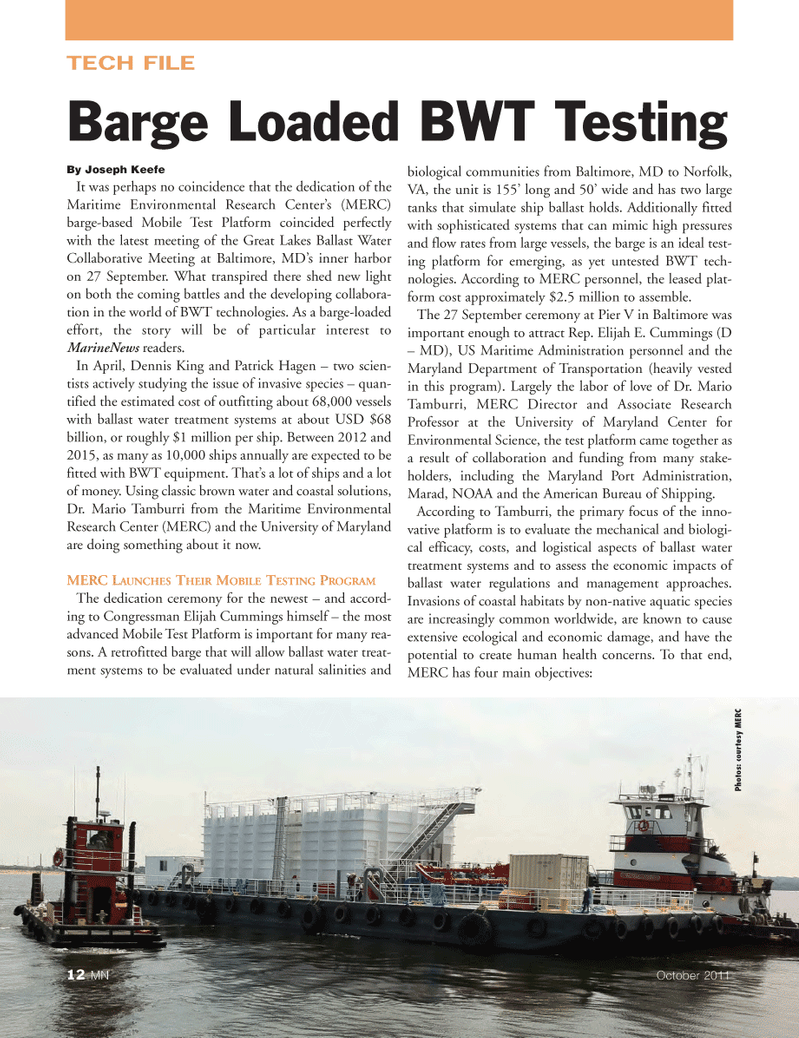
Page 12: of Marine News Magazine (October 2011)
The Yearbook
Read this page in Pdf, Flash or Html5 edition of October 2011 Marine News Magazine
TECH FILEBy Joseph KeefeIt was perhaps no coincidence that the dedication of the Maritime Environmental Research Center?s (MERC) barge-based Mobile Test Platform coincided perfectly with the latest meeting of the Great Lakes Ballast Water Collaborative Meeting at Baltimore, MD?s inner harbor on 27 September. What transpired there shed new light on both the coming battles and the developing collabora- tion in the world of BWT technologies. As a barge-loaded effort, the story will be of particular interest to MarineNews readers. In April, Dennis King and Patrick Hagen ? two scien- tists actively studying the issue of invasive species ? quan- tified the estimated cost of outfitting about 68,000 vessels with ballast water treatment systems at about USD $68 billion, or roughly $1 million per ship. Between 2012 and 2015, as many as 10,000 ships annually are expected to be fitted with BWT equipment. That?s a lot of ships and a lot of money. Using classic brown water and coastal solutions, Dr. Mario Tamburri from the Maritime Environmental Research Center (MERC) and the University of Maryland are doing something about it now. MERC L AUNCHES THEIRMOBILETESTINGPROGRAM The dedication ceremony for the newest ? and accord- ing to Congressman Elijah Cummings himself ? the most advanced Mobile Test Platform is important for many rea- sons. A retrofitted barge that will allow ballast water treat- ment systems to be evaluated under natural salinities and biological communities from Baltimore, MD to Norfolk, VA, the unit is 155? long and 50? wide and has two large tanks that simulate ship ballast holds. Additionally fitted with sophisticated systems that can mimic high pressures and flow rates from large vessels, the barge is an ideal test- ing platform for emerging, as yet untested BWT tech- nologies. According to MERC personnel, the leased plat- form cost approximately $2.5 million to assemble. The 27 September ceremony at Pier V in Baltimore was important enough to attract Rep. Elijah E. Cummings (D ? MD), US Maritime Administration personnel and the Maryland Department of Transportation (heavily vested in this program). Largely the labor of love of Dr. Mario Tamburri, MERC Director and Associate Research Professor at the University of Maryland Center for Environmental Science, the test platform came together as a result of collaboration and funding from many stake- holders, including the Maryland Port Administration, Marad, NOAA and the American Bureau of Shipping. According to Tamburri, the primary focus of the inno- vative platform is to evaluate the mechanical and biologi- cal efficacy, costs, and logistical aspects of ballast water treatment systems and to assess the economic impacts of ballast water regulations and management approaches. Invasions of coastal habitats by non-native aquatic species are increasingly common worldwide, are known to cause extensive ecological and economic damage, and have the potential to create human health concerns. To that end, MERC has four main objectives: Barge Loaded BWT Testing 12MNOctober 2011Photos: courtesy MERCMN#10 (1-17):MN 2011 Layouts 10/6/2011 11:47 AM Page 12

 11
11

 13
13
